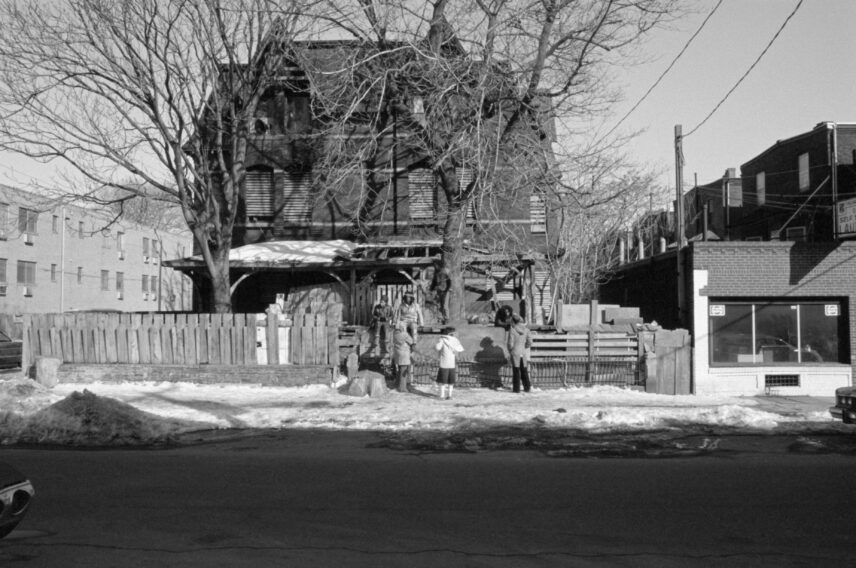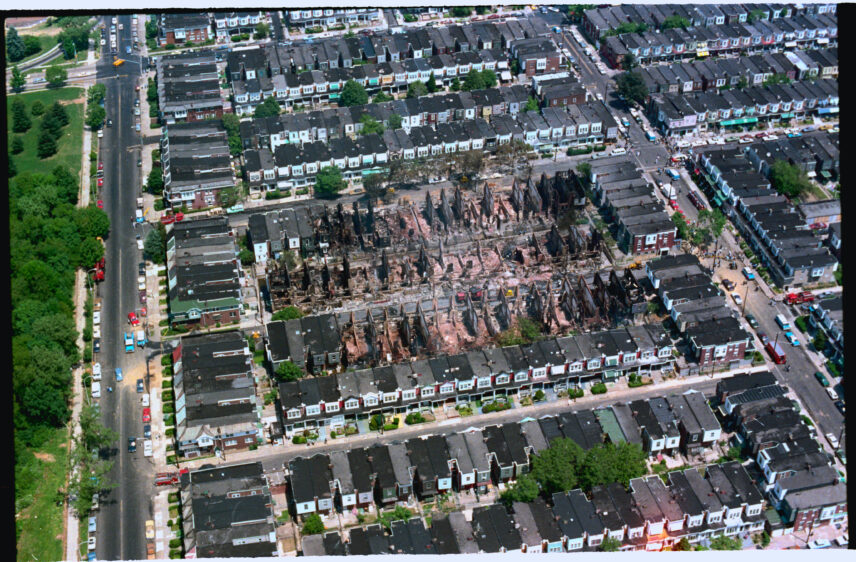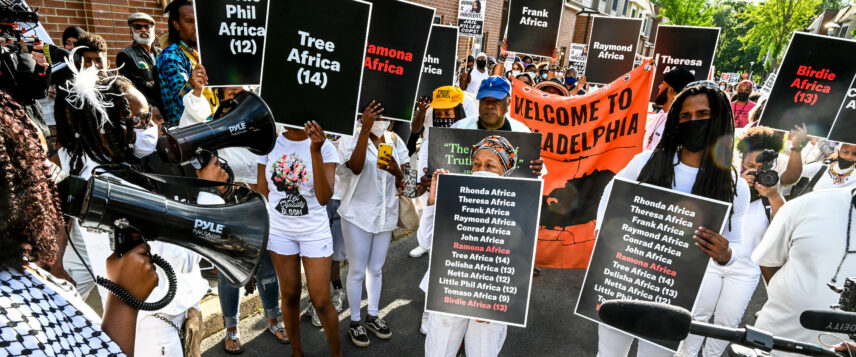Article begins
In a 1999 essay, “Memories—Pain of Separation,” Debbie Africa recalls one of her favorite memories of the children of MOVE. The year was 1976 and the Philadelphia-based revolutionary back-to-nature organization was preparing to send their children to rural Virginia to escape escalating confrontations with the police and city government.
Having volunteered to bathe the 11 children ahead of the journey, Debbie Africa, 20 years old and a new mother, paints a tender and comical scene of attempting to coax the children, one after another, into the bathtub. She begins with Tree Africa, the oldest at five years old, whose “real keen motherly instincts” she was counting on to help with the younger children. Next was Missy, a precocious two-year-old with a “cute, round face,” who returned to the tub pouting “I wanna get in the tub too” after every child bathed. There was Delisha, four, who was “the boss” of the other children. Little Phil, whose voice was raspy like his father. “Sweet” Netta kept Debbie’s six-month-old occupied while she bathed the others. But Linda, “strong-willed” at the age of three, was the only child who refused to take a bath. It took Debbie ten minutes to convince her to wash up and, when she finally returned to the bathroom with Linda in tow, she discovered Missy back in the tub for a third time.
“I couldn’t do nothing but laugh,” she remembered, of her last day with the children. This was two years before the city’s starvation blockade to evict MOVE from their communal home in the Powelton Village neighborhood of West Philadelphia. Before the militarized siege and arrest of a dozen MOVE members on August 8, 1978. Before her 1980 conviction as part of the MOVE Nine to sentences of 30–100 years.
And before the children’s murder by the city of Philadelphia.
I was happy in a way, cuz they wouldn’t have to be left there in the city to put up with them cops, but sad too because I would miss them a lot. I never imagined ever with everything we had already been through with them cops, that I’d never see most of them again. We sent them to Virginia to keep them from being hurt; when we brought them back a few years later, they were killed May 13, 1985.

The past haunts
Janet, Janine, and Sue Africa recollect in a 2021 WHYY interview that it took a prison guard at State Correctional Institution Muncy in central Pennsylvania less than a minute to inform them, “They just had a firebombing at your house and your children are dead.” In solitary confinement, there would be no bereavement calls or visits, no news reports. There would be no official condolences or apologies extended, save a letter posted six months later from the Medical Examiner’s Office (MEO) acknowledging the deaths of their children:
We regret to inform you that your child has been identified by the Philadelphia Special Investigation Commission’s Consultant as one of the victims in the MOVE house fire on Osage Avenue.
If you wish to claim the body, please have your funeral director contact us.
After MOVE relocated its headquarters to the Cobbs Creek area of West Philadelphia in 1981, the Osage Avenue rowhouse became the center of a renewed standoff with the city around the organization’s demand that officials release their political prisoners. On the evening of May 12, 1985—Mother’s Day—the city commenced its second full-scale offensive against MOVE by evacuating residents. At dawn, 500 police officers deployed to force MOVE to surrender, launched tear gas through holes drilled into the walls of the home, targeted a fortified bunker MOVE had erected on its roof with water cannons, and lobbed blocks of C-4 explosives onto the front porch, blowing it into the street. For 90 minutes, police fired 10,000 rounds of ammunition from military weaponry. At an afternoon press conference, the city’s first Black mayor, Wilson Goode, vowed that, after hours of unsuccessful attempts to draw, smoke, and blast MOVE out, the city would “seize control of the house by any means necessary.” In the early evening, police dropped a satchel bomb on the rooftop from a helicopter. The explosion’s impact was felt a mile away and immediately started a fire that the police commissioner directed firefighters to let burn. In her retelling, sole adult survivor, Ramona Africa, reveals further depths of state cruelty:
We immediately tried to get our children, our animals, ourselves out of the burning building. We were hollering, “We’re coming out!” [The police] immediately started shooting, trying to prevent anybody from coming out of that house. We were forced back in at least twice.
In one attempt, Ramona and 13-year-old Birdie Africa, escaped. However, as two full city blocks were allowed to burn to the ground, their family, five children and six adults, were burned alive:
Tree (14), Delisha (13), Netta (12), Little Phil (12), Tomaso (9),
Rhonda, Theresa, Frank, Raymond, Conrad, John Africa
The massacre of the MOVE children, who were made penal orphans by the incarceration of their parents, and their adult caregivers remains one of the most egregious instances of police violence in US history. That a municipal government would choose to bomb a home with children in it remains the most monstrous dimension of the greatest shame in the city of Philadelphia’s past, which continues to haunt its present—and the discipline of anthropology.

In a 2021 teaching video for a Princeton University online course, “REAL BONES: Adventures in Forensic Anthropology,” Penn Museum curator, Janet Monge, introduces the field of forensic anthropology using the “infamous” case study of MOVE. The course module would be the first public record that the remains of MOVE victims had not been buried as reported in 1986 and would be key to the exposé in April of this year that, for decades, the remains of two MOVE children—Tree and Delisha Africa—had been held at Penn Museum and later Princeton University, without the knowledge or consent of their living family members.
How did the remains of Black children murdered by the state become source material for anthropological adventures?
Sixty-one homes were destroyed as a result of the firebombing of MOVE, making the excavation process to recover remains challenging if not impossible. The 1986 report of the Philadelphia Special Investigation (MOVE) Commission determined that the MEO’s handling of the remains was “unprofessional and violated generally accepted practices,” ultimately resulting in the revocation of its certification. These malpractices included allowing unauthorized police sharpshooters to return to and disturb the crime scene; using a crane with a clamshell bucket to sift through the rubble while bodies were still being recovered, destroying not only “physical and medical evidence,” but also causing postmortem dismemberment and the commingling of human and animal remains. At the MEO laboratory, the recovered remains were improperly refrigerated—which accelerated their decomposition—and vital testing for metallic fragments consistent with gunshots was inexplicably not conducted. To this day, these lapses, which MOVE has always maintained were a “murder cover-up” have frustrated the process of settling whether MOVE members were killed by police gunfire or “accidentally” from smoke inhalation, as the city claims.
The mothers’ unflinching challenge to the ethics, praxis, and ostensive purpose of anthropology and the university should haunt this field and propel change.
In 1985, the Medical Examiner’s Office hired a Penn anthropology professor, Alan Mann (MEO) to join the forensics team identifying remains. Archival records show that Mann was paid $300 for 1.5 days of consulting work and, although there is no evidence of his graduate student Janet Monge being formally hired, she is recorded as his assistant. Despite these largely subordinate roles, Mann made headlines by publicly dissenting from the initial conclusions by the MOVE Commission concerning the identification of the remains. Mann insisted that the remains identified as Tree Africa belonged to an adult and that those identified as Delisha Africa belonged to a much younger child—claims the MOVE Commission chief counsel said caused undue “emotional trauma” to the family and city. After additional testing, the initial conclusions were confirmed, and the remains are documented as being requested by and released to the families or chosen representatives for burial.
Haunting remains
At an April press conference organized by MOVE days after the horrifying revelations went public, three of the mothers of MOVE children murdered on May 13, 1985—Janet, Janine, and Consuewella Africa—addressed the public to “get straight” their position. “The Power of the Truth is Final,” a core MOVE teaching attributed to founder John Africa, which was displayed at the center of the dais table, instructs us to collectively witness the truth, rage, grief, and demands of MOVE. The livestreamed event, archived at onamove.com, should be required viewing for all anthropologists, archeologists, and museum workers. In particular, the mothers’ unflinching challenge to the ethics, praxis, and ostensive purpose of anthropology and the university should haunt this field and propel change that is aligned with MOVE’s radical leadership:
I see a news article of them saying, not only did they kill my children, kill my sisters and brothers, but they have desecrated what they say are their remains. Defiled them and had them hidden away on exhibit as a learning tool for their students. That is the most disrespectful, hateful thing to do to anybody, but especially children. And this is what MOVE is talking about: why we don’t trust this system and why we are so angry at the system.
—Janine Africa, mother of Little Phil and Life Africa
We would have never found out [about the remains] if it wouldn’t have gotten exposed. They’re not doing this for us out of sincerity. If this story hadn’t come out, no one would have known, and they’d have still been holding onto the remains in some kind of drawer.
An honest person that had any type of feelings would have contacted the mothers of those children. They knew where we were. Everybody knew where we were. I was in the state penitentiary for 41 years. Why didn’t your museum notify me and ask me did I want something?…We just want to make this clear and we just really want you all to see the horrendous attitude of these officials and these noted professors that everybody respects so much—and understand why we don’t.
They would not even allow our children, our adults, our animals to rest in peace…And not only did they do that, but they lied about it. We never knew anything about the remains of our family. Nothing. We were in jail…When I read an article, it said that they had the remains of our family, and that they had told us about it, and that we knew about it, which you know is not true.
—Janet Africa, mother of Delisha Africa
When our babies are born, they kill them. When they’re growing up, they kill them. When they get older as adults, they kill them…over and over. And now after so called death…they’re going to do this?
Some 36 years later, they talking bout they got some bones from the remains of our children? You go to hell with that bullshit!
—Consuewella Africa, mother of Tree and Netta Africa
This is a continuous, nonstop, vicious, violent, sadistic, ongoing abuse of The MOVE Organization. Why? Because we stand up and tell the truth about this rotten reform world system. We expose them for the criminals that they are. But, yet my sisters and brothers did 40 damn years in jail for something they didn’t do.
The power in these truths require more than the largely restrained and performative public statement-as-apology, which has been the overarching modality of recognition and redress in the wake of the uncovering of anthropology’s participation and complicity as a discipline, institution, and practice, in the desecration of the dead and incalculable harm to the living members of MOVE. In an early press statement, Penn Museum described the exploitation of the remains of Delisha and Tree Africa as a “serious error in judgment.” Nearly every institutional and professional statement on this matter has reproduced white supremacist moves to innocence: in particular, the notion that Alan Mann and Janet Monge held hostage the remains for decades as part of a “continued investigation” to establish their identities. It is an insult to the lives, spirits, and memory of the 11 MOVE members murdered by the state and their surviving loved ones to provide cover for the indisputable reality that this was no judgment error, but in fact state-sanctioned theft and trafficking of the dead—what MOVE Minister of Confrontation, Pam Africa, describes more bluntly as the work of “body snatchers” and “grave robbers.”

If, as the Association of Black Anthropologists argues in its collective statement concerning the Children of MOVE, anthropology must “actively work to undo the centuries of violence and trauma done to nonwhite communities,” what is owed MOVE specifically? MOVE emphatically rejects the adequacy of apology and the very possibility of repair. Consuewella Africa, who survived 16 years of political imprisonment and the murder of her daughters, Netta and Tree Africa, died on June 16, 2021, at the age of 67 less than two months after learning the remains of Tree were held at Penn Museum. In a press statement, MOVE identifies “the stress of the situation” as a factor in her health complications and death. There is blood on the hands of the discipline and the university. What would it mean for the perpetrators and complicit parties of the desecration of the remains of Delisha and Tree Africa to be held publicly accountable instead of professionally and legally protected? What would it look like for the culpable institutions, for the discipline of Anthropology itself, to voluntarily enter a reparative process of restitution for MOVE? How might we professional anthropologists honor the one demand MOVE has consensus around—the release of political prisoner Mumia Abu Jamal—and organize toward his release in honor of Delisha and Tree Africa and MOVE?
The recently published Fifty Years on a Move, an organizational history of MOVE co-written by second-generation MOVE member, Mike Africa Jr., in commemoration of its fiftieth anniversary in 2022, asserts that “MOVE is not an acronym. It means exactly what it says, MOVE, work, generate, be active.” How will we now be moved to action?
This article was amended on November 3, 2021 to move the position of the words “for decades” in the second sentence in paragraph nine. For greater clarity, this phrase has been moved forward in the sentence.

